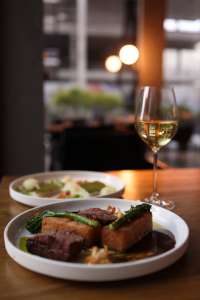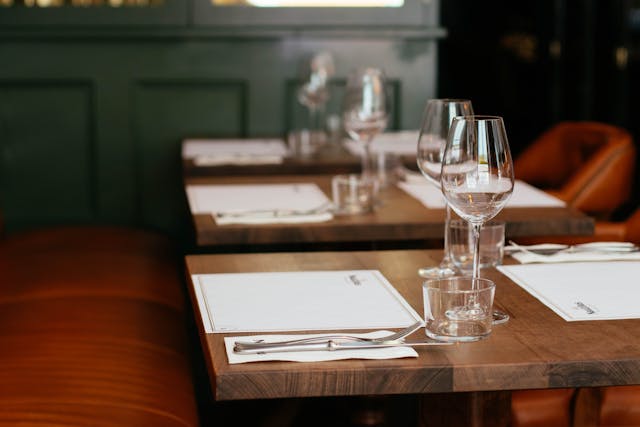When I step into a restaurant, one of the first things I look forward to is the wine list. There’s something about a well-curated selection that adds a whole new dimension to the dining experience.
If you observe multiple restaurant wine lists, Cabernet Sauvignon, Chardonnay, and Prosecco are frequently included, almost guaranteed. This isn’t a coincidence…these wines have earned their place on menus. With that being said, you’re likely wondering why and how those wines made it on the wine list. Well, ponder no more; let’s get into the thought process of curating a wine list and the appeal of each wine type.
Why Have These Specific Wines Become Staples?

Universal Appeal and Approachability
Certain wine types, like Pinot Grigio or Merlot, are popular because they’re approachable for a wide range of palates. Restaurant wines tend to have balanced flavors—neither too bold nor too subtle—which makes them easy to enjoy whether you’re a seasoned wine enthusiast or someone simply looking for a pleasant drink. For example:
- Cabernet Sauvignon: Its bold, fruit-forward flavors and firm tannins make it a safe bet for red wine drinkers.
- Chardonnay: Its wide range of styles (from crisp and unoaked to rich and buttery) ensures there’s an option for almost everyone.
Versatility with Food
Restaurants prioritize wines that pair well with a variety of dishes. These wines often have balanced acidity, moderate tannins, or a touch of fruitiness, making them flexible enough to complement different cuisines. For instance:
- Sauvignon Blanc: Its crisp acidity cuts through rich sauces, while its herbal notes enhance lighter, vegetable-forward dishes.
- Pinot Noir: A crowd-pleaser that pairs just as well with salmon as it does with roasted chicken or duck.
Familiarity With Guests
Recognizable wine names like “Malbec” or “Prosecco” are more likely to catch a diner’s attention. Even if someone isn’t a wine expert, they may feel comfortable ordering a glass of Merlot because they’ve heard of it before. Restaurants often stick to well-known varietals to make the wine list feel accessible.
Trends and Popularity
Wine trends also influence what ends up on menus. For example:
- Prosecco has surged in popularity thanks to its affordability compared to Champagne, making sparkling wine more accessible for casual occasions.
- Rosé has seen a massive resurgence as a year-round favorite, driven by social media and its reputation as a fun, versatile choice.
Value and Availability
Restaurants need wines that are consistently available and reasonably priced. Popular varietals like Malbec (from Argentina) or Cava (from Spain) often deliver excellent quality without breaking the bank, making them a smart choice for both the restaurant and the guest.

How Restaurants Decide What Wines to Offer
Creating a wine list is an art and a science. Restaurants don’t just pick wines at random—they carefully curate their selection to balance variety, quality, and profitability. Here’s how the process typically works:
Understanding the Concept of the Restaurant
The type of cuisine, ambiance, and target audience heavily influence the wine list. For example:
- A fine-dining steakhouse will likely feature bold reds like Cabernet Sauvignon or Syrah.
- A seafood-focused restaurant might prioritize crisp whites like Sauvignon Blanc, Riesling, or Albariño, as well as sparkling wines.
- A casual Italian trattoria might lean toward Italian wines like Chianti, Barolo, or Pinot Grigio.
The goal is to match the wine list with the overall dining experience.
Collaboration With Distributors
Restaurants work closely with wine distributors and importers to source their selections. Distributors often recommend wines that are best-sellers or have a strong reputation. They may also provide tastings, so restaurant managers or sommeliers can evaluate the wines before deciding.
Balancing Variety and Focus
A good wine list offers something for everyone while maintaining a streamlined focus. For example:
- Variety: A mix of reds, whites, rosés, and sparkling wines ensures there’s an option for every taste and meal.
- Focus: Restaurants often concentrate on wines from specific regions or styles that complement their cuisine, such as offering mostly French wines at a French bistro.
Pricing Strategy
Restaurants must consider how wines are priced. Most wine lists include options at a range of price points, from affordable house wines to higher-end bottles. Pricing also reflects the restaurant’s markups, which typically range from 2x to 4x wholesale costs.
Staff Input and Training
Staff feedback is crucial. Servers and bartenders often interact directly with customers and can provide insights into what sells well. Additionally, restaurants invest in staff wine training so they can confidently recommend pairings and describe wines to guests.
Spotlighting Local and Seasonal Wines
Many restaurants include local wines or seasonal picks to appeal to customers who value sustainability or regional flavors. For instance, a California restaurant might feature Napa Valley wines, while a bistro in Oregon might highlight Pinot Noir from the Willamette Valley.
Offering House Wines
House wines are often chosen for their affordability, consistency, and general appeal. These are usually sourced from bulk producers or lesser-known wineries. While house wines aren’t always the most complex, they’re a practical restaurant wine for diners who want a no-fuss option.

Restaurant wines are carefully curated to enhance your dining experience. Whether you gravitate toward a bold Cabernet, a crisp Sauvignon Blanc, or a bubbly Prosecco, there’s a reason each wine has earned its spot on the list. So, the next time you’re browsing a wine menu, take a moment to appreciate the thought that went into crafting it—and don’t hesitate to ask your server for guidance. After all, wine is meant to be savored, shared, and, most importantly, enjoyed. Cheers!





